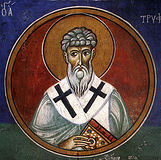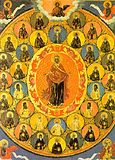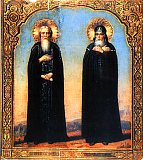

| Previous day | Next day |
| Old Style
June 13
|
Sunday |
New Style
June 26
|
|
2nd Sunday after Pentecost. Sunday of All Saints of Russia.
Tone 1.
Fast of the Holy Apostles. |
Fish, wine and oil allowed.
|
![]() Martyr Aquilina of Byblos in Lebanon (293). St. Alexandra, foundress of Diveyevo Convent (1789).
Martyr Aquilina of Byblos in Lebanon (293). St. Alexandra, foundress of Diveyevo Convent (1789). ![]() St. Triphyllius, bishop of Leucosia (Nicosia) on Cyprus (ca. 370).
St. Triphyllius, bishop of Leucosia (Nicosia) on Cyprus (ca. 370).
Martyr Antonina of Nicaea (ca. 284-305). St. Anna of Larissa in Thessaly (826) and her son John (9th c.). St. Andronicus, disciple of St. Sergius of Radonezh (1395), and St. Sabbas (15th c.), abbots, and St. Daniel (1428), iconographer, all of Moscow. ![]() Sunday of All Saints of Mt. Athos. Sunday of All Saints of Palestine. Sunday of All Saints of Romania. Sunday of All Saints of Bulgaria. Sunday of All Saints of the Iberian Peninsula. Sunday of All Saints of the Czech Lands. Sunday of All Saints of America.
Sunday of All Saints of Mt. Athos. Sunday of All Saints of Palestine. Sunday of All Saints of Romania. Sunday of All Saints of Bulgaria. Sunday of All Saints of the Iberian Peninsula. Sunday of All Saints of the Czech Lands. Sunday of All Saints of America.
Synaxis of New Martyrs and Confessors of Zaporozhie (Ukraine).
Kaluga Icon of the Most Holy Theotokos (1748).
St. Antipater, bishop of Bostra in Arabia (458). New Hieromartyr Anthimus the Georgian, metropolitan of Wallachia (1716). Martyr Diodorus of Emesus.
Repose of Archimandrite Dimitry (Egorov) of Santa Rosa, California (1992).
Thoughts for Each Day of the Year
According to the Daily Church Readings from the Word of God
By St. Theophan the Recluse

Second Sunday After Pentacost. [Rom. 2:10-16; Matt. 4:18-23]
The Lord called Peter and Andrew, and immediately, leaving all, they followed Him. He called James and John, and they also immediately left all and followed the Lord. Why did they follow Him so quickly and willingly? Because they saw something better. Such is the law that we have in our soul, that once it has tasted and known what is better, it is repulsed by what is worse and abandons it. Here is accomplished the same thing that later the Lord described in His parable about the treasure hid in a field, and about the pearl of great price. The treasure and the pearl are faith in the Lord and communion with Him according to the strength of faith. We have already been declared possessors of this in baptism. Why do we value this treasure so little, and so exchange it for barren insignificance? Because we were not brought up to cultivate a taste for this treasure, and it becomes foreign to our heart. Our heart does not know this better thing. It only knows that there is the bad, the very bad, and the not so bad, and bases its outlook upon this assessment. Here is the entire reason why the Lord calls some and they come; but we, the chosen ones, run from Him.
Articles
 Martyr Aquilina of Byblos in SyriaThe Holy Martyr Aquilina, a native of the Phoenician city of Byblos, suffered under the emperor Diocletian (284-305). |
 Martyr Antonina of Nicea, in BithyniaAfter fierce tortures, Saint Antonina was thrown into prison, but Maximian could not force the saint to renounce Christ and offer sacrifice to idols. |
 St. Anna and Her Son of ConstantinopleSaint Anna and her son Saint John lived in the ninth century. |
 Venerable Sava the Abbot of MoscowSaint Sava of Moscow succeeded Saint Andronicus as the igumen of the monastery of the Savior, dedicated to the Icon of Christ Not-Made-By Hands (August 16) in 1395. |





